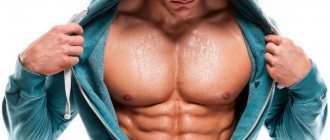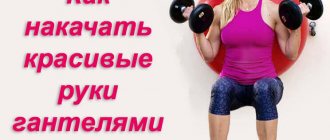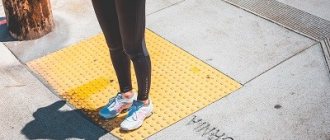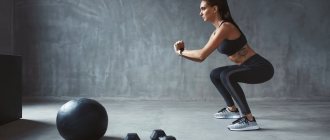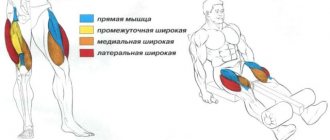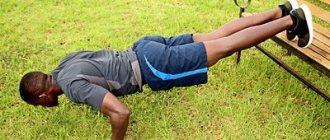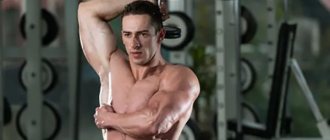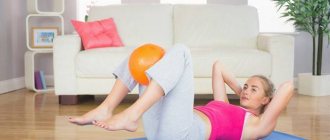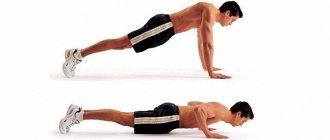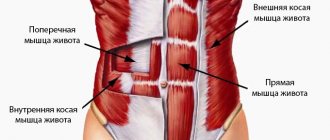In this article we will tell you a technique on how to pump up your arms at home without dumbbells and barbells using your own weight for girls and guys. Guys want to pump up their biceps and triceps to make their arms bigger. Girls need to train their arms to be slim and keep them in good shape.
These hand exercises at home are suitable for both women and men. To make the complex universal, each exercise is offered in different variations to increase the load for men and reduce it for women, respectively. If you have any questions, feel free to ask them in the comments and get an answer.
How to pump up your arms at home without dumbbells
Muscular arms, just like pumped up abs, make a huge impression on others. That is why their development is so important.
Developed biceps, triceps, shoulders, forearms - you are not born with them (unlike the calf muscles, the size of which is largely determined by genetics), this is achieved through long training.
The owners of fitness rooms know this, so everything there is equipped for convenient arm training.
But if you travel or work somewhere far away, you will have to use a trick. In addition to regular classes in the gym, you will need to do arm training without exercise equipment.
Luckily, there are a number of at-home arm exercises that you can do almost anywhere. They mainly use your own body weight.
To understand how to build up arm muscles at home without dumbbells, you need to study the anatomy of the arms and understand what makes them what they are.
Rules and tips
Before you learn how to pump up your arms at home without dumbbells and barbells, you need to familiarize yourself with important recommendations. If you follow all the tips described, you can greatly increase your muscle growth progress!
- You don't need to train your arms too often. Many beginners mistakenly believe that the more often they pump their biceps, the sooner they will grow. This technique leads to overtraining, and in this situation you can completely forget about muscle growth! The arm muscles need to be trained no more than 1-2 times a week so that they have time to recover.
- You don't need to train just your arms. Unfortunately, many novice athletes are only interested in how to pump up their biceps without dumbbells and barbells at home. Such people do not understand that for the full development of muscles it is necessary to train other parts of the body (chest, back, legs, etc.). Only in this case can you achieve a beautiful and aesthetic physique!
- Rest is our everything. Do not forget that muscle mass grows not during training, but during rest. If you engage in heavy physical activity every day and sleep less than 7-8 hours, you can forget about your training progress forever.
- Proper nutrition. Healthy and natural food is the basis of the muscle base of any iron sports fan. You may ideally know how to pump up your biceps without dumbbells and barbells, but without a proper diet consisting of natural proteins and carbohydrates, you should not expect great success in training. Proteins can be obtained, for example, from eggs, milk, cottage cheese and other dairy products, and carbohydrates from cereals and pasta. The former are responsible for the restoration of muscle fibers after heavy physical activity, the latter for energy.
- Progression of loads. Most people who are interested in how to pump up biceps without dumbbells and barbells at home do not even suspect that increasing working weights is the key to muscle growth. The stronger we become, the larger our muscles become. To start that same mass-gaining process, you need to do each exercise in 3-4 sets of 8-12 times (this applies to almost all muscle groups). If an athlete feels that he can perform 12, 15 or more repetitions, then this means that he needs to increase the weight. The main thing is to do this very gradually and slowly, so as not to get seriously injured!
- Warm up. Unfortunately, many novice bodybuilders do not pay attention to this important point, which is why their joints and muscle tissue later suffer. A good warm-up is necessary in order to prepare the body for subsequent serious loads. Before class, be sure to set aside 5-10 minutes for a comprehensive warm-up of all muscles and joints.
Anatomy of arm muscles
The main muscles of the arms are the biceps and triceps. These are the areas we will focus on to improve the appearance of our arms and increase their strength.
You should reconsider your attitude towards training with light weights and high repetitions (15+). This is suitable for both women and men.
To make the muscles grow (which gives them shape and relief / makes the muscles toned) you need to load them with exercises that can be performed with excellent technique 6-12 times per approach.
It is normal for you to focus more on training one muscle than others if you are faced with such a task (for example, if that muscle is lagging). But provided that the remaining muscles are sufficiently developed to avoid disproportion and injury.
Triceps
Men often neglect the development of the triceps muscle, which is located on the back of the arms. They prefer to pump their biceps because its shape is clearly defined and visible to the eye.
But the triceps are a larger muscle group than the biceps, and if you want bigger arms, you should add a little more emphasis on pumping them up.
Triceps training is important not only for men. The fact is that women are genetically more inclined to accumulate fat than men. And their fat is located in different places. As a rule, in men in the upper part of the body (hence the “beer” bellies), and in women on the thighs and arms.
The most effective way to lose fat is through diet. But it is also important to combine it with training to strengthen the muscles of the arms, in particular the triceps, to give the arms a beautiful shape and “fitness”.
Biceps
Although it is a relatively small muscle, this does not mean that it should receive little attention. Located on the front of the shoulder, it's perhaps most commonly associated with strength and power—just ask any child to imitate a bodybuilder's workout routine and they'll start doing a bicep curl.
Strong biceps are needed in back exercises. They help maintain a straight posture and help avoid injury.
Now let's get down to the main thing - how to pump up arm muscles at home. And for this we have prepared the best exercises with varying degrees of difficulty.
Ground pumping program
The following training program with dumbbells and barbells at home will help you achieve good results:
- Lifting dumbbells for biceps with supination (reversal).
- Arm bending without supination (“Hammer”).
- Elbow push-ups.
- Bench press due to the movement of the forearm.
- Extension of arms from behind the head.
- Raising the barbell for biceps with a reverse grip.
- Bent over arm extension.
While performing the complex, you can use dumbbells, a kettlebell or a barbell. All elements are performed 6-12 times four times, and push-ups - from 12 to 15 times. Rest between sets is 1-2 minutes.
If desired, the complex can be supplemented with an exercise to pump up the leg muscles.
Mass exercises with dumbbells and other equipment at home will help strengthen your muscles in a week.
The best triceps exercises without dumbbells and machines
With these exercises you can pump up your arms at home without dumbbells, barbells or even exercise machines.
The great thing about triceps (and chest) exercises is that they can be done anywhere. This requires nothing more than the floor and walls. Here are the 3 best exercises:
1. Push-ups with narrow arms (diamond or diamond push-ups)
Close-grip push-ups (here we are looking at a variation called diamond push-ups) are not an easy exercise, but when done correctly they are one of the best for the triceps.
In regular push-ups, your arms are placed slightly wider than your shoulders, so the load is distributed between the chest and triceps. And with a narrow grip, only the triceps are loaded, because in it the palms are placed together and the elbows are kept close to the body.
Here's how it should be done:
- Place your hands on the floor, connecting the thumbs and index fingers of both hands, creating a “diamond” (triangle) shape.
- Keeping your elbows as close to your body as possible, lower yourself down until your chest touches the outside of your palms.
- Keep all muscles (abs, buttocks, thighs) tense
- Raise your body up to the starting position. Then do it all over again.
Lightweight options (if the usual method is too difficult):
- Close-grip wall push-ups
- Close-grip push-ups with emphasis on a bench (or any other elevation)
- Regular push-ups
Complicated options (if the usual method is too easy):
- Close-grip push-ups with feet resting on a height (for example, a chair)
- Close-grip push-ups with weights (such as a backpack)
Triceps push-ups
This is another exercise that works the chest and triceps to varying degrees, depending on the variation you choose.
For most people, this exercise will be a good place to start, but your goal should be to progress to dips (they involve more muscles in the work).
The only downside to dips is that you have to find something suitable to do them. On playgrounds, bars are most often present, but instead of them, you can use the corner of a table or two strong chairs.
Here's how to do this exercise according to the video above:
- Maintain balance between two benches or chairs, keeping your feet on one and your hands on the opposite side.
- Push your chest forward and keep your back straight.
- Lower yourself until your elbows are bent at about a 90-degree angle.
- Then rise up, straightening your arms.
Lightweight options:
- Triceps push-ups with bent knees (feet on the floor)
- Bench push-ups for triceps with feet on the floor
More complicated options:
- Triceps push-ups with weights. Place your backpack or suitcase on your hips.
- Dips
- Weighted dips (hang a heavy backpack or use something that can be secured between your legs).
Triceps extension
All of the previous exercises are great because they work multiple muscles at the same time.
But single-joint, or isolated, exercises are very useful for working out lagging muscles. The video above shows the exercise using a TRX machine and a weighted vest, but you can use a wall or other surface.
Here's how it's done:
- Stand in front of the TRX, table, or wall and place your hands about 15 centimeters apart.
- Place your feet about a meter from the wall. Maintain tension in your abs and glutes to keep your body in a straight line.
- By bending only your elbows, lower your entire body so that your head drops just below your hands.
- Do not make any movements with your elbows other than flexion and extension.
- Lift your body using only triceps strength.
Lightweight version:
- Triceps extension from the wall (the position of your hands and the smaller the angle between your body and the wall, the easier)
Complicated option:
- Triceps extension from the floor
Exercises for the pectoral muscles
Dumbbell bench press
The dumbbell bench press is a basic exercise for developing chest muscles. Depending on the level of inclination of the bench, you can vary the load and load certain parts of the pectoral muscles more. For example, a dumbbell bench press puts more stress on the middle part of the chest. When pressing dumbbells on an incline bench, the upper part and front deltoid muscles work more. When you press dumbbells on a bench with a negative incline (head down), you focus the load on the lower chest.
However, the technical principles are the same for all types of dumbbell presses. It is performed as follows:
- Take dumbbells and lie down with them on a bench, straighten your arms in front of you. Place your feet firmly on the floor. The back is slightly arched, but not much, the shoulder blades are brought together.
- As you inhale, lower the exercises down to a comfortable point. It is not necessary to lower them as low as possible; in this case, you will most likely feel pain or discomfort in the shoulder joints. It is better to work in a comfortable amplitude, maintaining a constant load in the working muscles in both the positive and negative phases of the movement.
- As you exhale, begin to press the dumbbells upward, trying to further strain your pectoral muscles as you lift the weights. At the top point, do not fully extend your elbows; immediately begin a new repetition.
Bench press:
Incline Press:
Makatserchyk - stock.adobe.com
Reverse Bench Press:
Makatserchyk - stock.adobe.com
Dumbbell flyes lying on a bench
Dumbbell flyes lying on a bench are an isolating exercise for local development of the pectoral muscles. Unlike the bench press, the negative phase of the movement is much more important in the fly; you need to concentrate as much as possible on the feeling of stretching in the muscle fibers. By analogy with the bench press, flyes can be performed on a bench with different levels of incline to emphasize the load on different parts of the pectoral muscles.
The technique is as follows:
- Take dumbbells and lie down on a bench. The first movement is to press the dumbbells up and start fly-ups from the top position.
- Hold the dumbbells parallel to each other and begin to lower them to the sides, keeping your elbows slightly bent. Lower them until you feel a maximum stretch in the outer chest. The movement should be smooth, so it will be easier for you to focus on stretching and contracting the muscles.
- In the positive phase of the movement, you need to return your arms almost to their original position. It is not necessary to complete the movement; in the last 20-30 cm of the movement, the pectoral muscles hardly work, and all the work is done by the anterior bundles of deltoid muscles.
Makatserchyk - stock.adobe.com
Dumbbell push-ups
Dumbbell push-ups are an exercise that loads the middle and lower parts of the chest, performed with your own body weight. This exercise is common in CrossFit because it gives you the opportunity to load slightly different muscle fibers by working with your body rather than with additional weights. In addition to the chest, the load falls on the triceps and anterior deltoids, and the abdominal muscles, buttocks and spinal extensors act as stabilizers in this movement.
This is done as follows:
Place dumbbells on the floor slightly wider than shoulder height. Grab them with your hands using a closed grip.
It is important to correctly distribute the center of gravity so that the dumbbells do not move apart when lifting; try to keep them at the level of the lower chest throughout the entire approach. Slowly lower yourself down while inhaling. The greater the range of motion, the better, so try to touch your chest to the floor if the stretch and elasticity of your shoulder joints and ligaments allows you to do so. Push up from the bottom position, squeezing your pectoral muscles.
Tighten your triceps and wrists to prevent the dumbbells from moving apart as you lift them up. At the top, you don’t have to fully extend your arms.
Jovan - stock.adobe.com
Pullover
This exercise could also be classified in the back category, since the pectorals, triceps and lats are actively working here. But when performing a pullover with a dumbbell across a bench, it is the pecs that receive the greatest load.
Execution order:
- You need to lie across the bench so that you rest your upper back on the bench. Also, plant your feet firmly on the floor.
- Take a dumbbell in your hands, lift it to outstretched arms and, while inhaling, slowly begin to lower it behind your head. There is no need to bend your arms, then you will practically not use the triceps.
- As you exhale, return to the starting position - your arms are perpendicular to your body.
Nicholas Piccillo - stock.adobe.com
Reverse grip biceps pull-ups
This is my favorite exercise after the deadlift.
Here, as in regular pull-ups, the back works. But thanks to a different grip, a lot of the load falls on the biceps.
I have always believed that pull-ups are better than dumbbell curls due to the inclusion of more weight (your own body weight) and a greater range of motion.
This is another exercise that can be difficult for beginners, so some modifications are given below. But if you think you can handle it, here are the instructions:
- Grasp the bar with both hands. The grip width is narrower than shoulder width. Palms pointing towards you.
- Do not relax your abs and buttocks so that your body in profile resembles a straight line.
- During execution, bring your shoulder blades together and, as it were, pull them down.
- When your chin reaches the bar, stop and slowly lower yourself down.
Lightweight options:
- Negative pull-ups
- Isometric holds on the horizontal bar
Complicated option:
- Regular grip pull-ups
- Bicep pull-ups with weights
Options for home
When considering ways to pump up your biceps without dumbbells, you should consider two options:
- training without any equipment;
- and training with your own body weight in the presence of a crossbar.
Bicep push-ups
This is the only exercise that can be done on the floor for biceps. It is important to perform the movement not in quantity, but at a slow pace and under control, feeling the tension in the target muscle.
Technique:
- Assume a push-up position, but place your hands at stomach level. Turn your palms to the side and away from you (at an angle of 45 degrees).
- Do push-ups, bending your elbows, try to lower your body so that your chest is 1-2 cm from touching the floor.
- Straighten your arms with a powerful movement and repeat the movement.
This exercise may seem difficult at first, so try to perform 5-6 repetitions per set, gradually increasing the number of repetitions to 10 or even 15.
Biceps pull-ups on the horizontal bar
If you have a bar, this is the main movement with which you can pump up impressive volumes of biceps. In addition to the biceps brachii, it also uses the rest of the muscle areas of the arms, as well as the anterior deltoids. This can be considered an advantage, as it helps to increase the total mass of the shoulder girdle and upper limbs.
Technique:
- Hang from the bar, holding it with an underhand grip. Place your hands optimally at shoulder width.
- Pull yourself up, trying to pull your chin towards the bar.
- Pause, then return to the starting position at a slower pace.
Horizontal pull-ups
This is a movement that works with any low bar, raised support, TRX loops, or other devices that allow you to grab your hands at chest or stomach level.
Technique:
- Grab the bar with an underhand grip. Tilt your body so that you rest on your heels. The body should be straight from the feet to the shoulders and neck.
- Bend your elbows, trying to bring your upper chest to the bar as close as possible.
- Pause and slowly return to the starting position.
If there is no low bar, then you can do pull-ups on a table with a straight grip.
Horizontal pull-ups
Even when I'm working on my back at the gym, I choose horizontal pull-ups.
You may have heard of the bent-over barbell row. You grab a barbell, bend over, and pull the barbell toward your chest. This is a good exercise if done properly. But if the weight is heavy, it becomes difficult to perform the exercise with proper technique.
Horizontal pull-ups solve this problem. The technique of performing this exercise is difficult to spoil; weights can be added without the risk of increasing the risk of injury.
In addition to the back, they are also a great workout for the biceps and core.
Watch the video training for this exercise and follow these instructions:
- Lie on the floor under a bar or table.
- Grab the bar or edge of the table so that your palms are facing away from you.
- Maintain tension in your abs to keep your body in a straight line.
- Pull your body up until your chest touches the bar or table.
- Then lower yourself.
Lightweight options:
- Pull at the doorway
- Traction with a rag
More complicated options:
- Horizontal pull-ups with increased leg support
- Horizontal pull-ups with weights (for example, a backpack)
Tips: How a girl can quickly pump up beautiful arms at home
You don't have to visit expensive fitness clubs to get beautiful athletic hands. Most of the exercises are quite accessible for home workouts.
In order to work productively on a problem area at home, you may need the following equipment:
- dense small mat;
- stable support: block, bench, chair;
- horizontal bar/crossbar;
- a set of weights of different weights;
- expander;
- fitball
In the first couples, you can do without any equipment at all, or use a minimal set: a mat, a pair of dumbbells (you can take 1-1.5 liter water bottles) and any suitable support.
